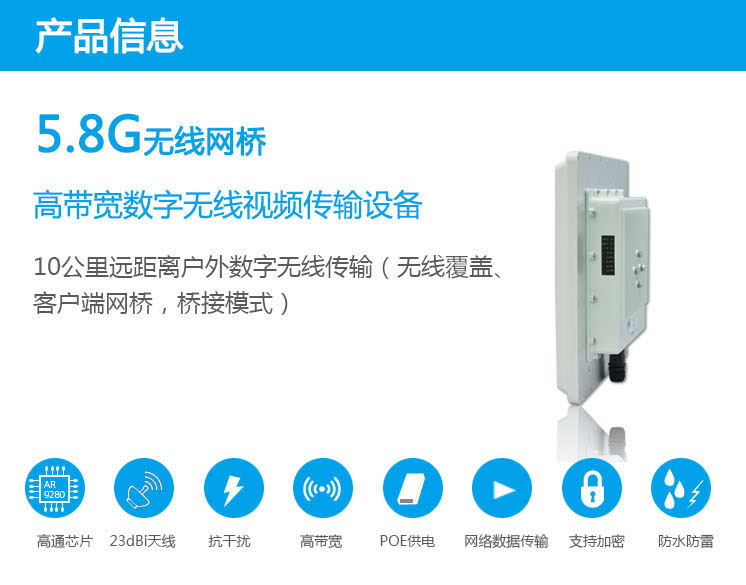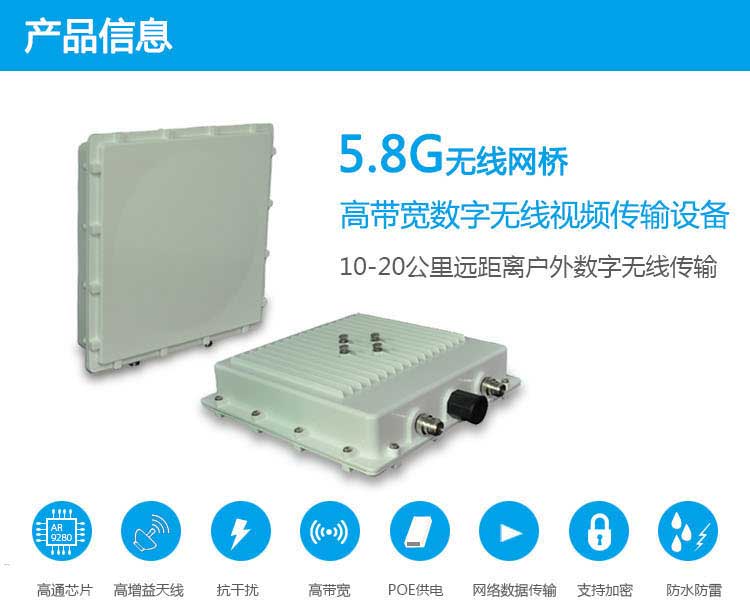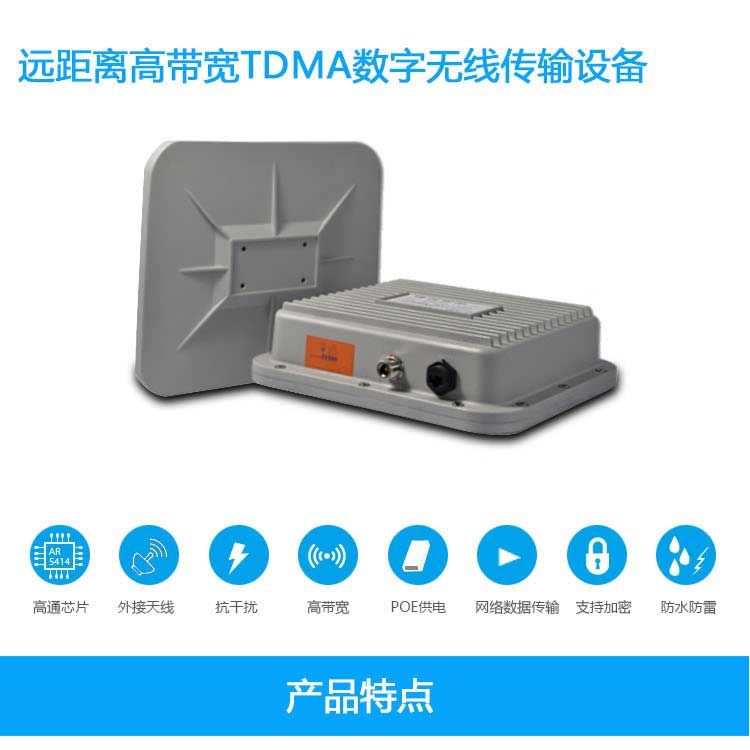New driver teaches you to choose wireless surveillance system dedicated wireless bridge
What wireless bridge is better for wireless monitoring?
Now many outdoor security monitoring projects have chosen to use wireless monitoring to replace the existing cable monitoring network, and wireless bridges are the most common wireless transmission devices in wireless monitoring systems.
There are many types of wireless bridges available in the market for wireless monitoring systems. The quality of wireless bridges varies widely, so consumers can't determine which wireless bridge is what they want. Of course, starting from the brand's point of view, choosing a high-profile branded equipment will not usually be a big mistake, but in order to make our choice not too narrow, we can also choose from other aspects suitable for us. Wireless bridge.
1. Wireless Bridge Work Channel There are two common wireless bridge work channels: 2.4G and 5.8G.

In the city's wireless monitoring projects, such as construction site wireless monitoring, road wireless monitoring, community wireless monitoring and other wireless monitoring projects, it is best to use 5.8G wireless bridge.
So now there are a lot of WIFI devices in the city, and the microwave channel most used for WIFI signals is 2.4G. In order to avoid interference, it is better to use 5.8G wireless bridges in the city.
The 2.4G channel wireless bridge is only used in the suburbs, such as near-distance transmission distance, or in some special environments, such as park wireless monitoring, tunnel wireless monitoring, and so on.
5.8G has strong anti-interference ability and transmission ability to 2.4G wireless bridge, so for some projects that require long-range wireless transmission, most of them are wireless bridges using 5.8G channels. For example, ST5023PRO, this 5.8G wireless bridge can transmit 100 kilometers.
The 5.8G channel wireless bridge has gradually become the mainstream device of the wireless monitoring system. 2.4G is gradually transformed into a WIFI coverage device, or mixed with a 5.8G wireless bridge, and becomes a dual-band wireless bridge. For example, ST-5824TN, this is a dual-band wireless bridge with both 2.4G and 5.8G.
Of course, when doing wireless monitoring solutions, it is necessary to select devices according to the site conditions. If there are 5.8G signals everywhere, then in order to avoid interference, it is a good choice to use the 2.4G channel. The emphasis is on random adaptation. Keep system stability.
Second, wireless bridge transmission distance and bandwidth In the wireless monitoring system design early stage, we must consider the various monitoring points and the transmission distance to the monitoring room, corresponding to each monitoring point, we need to find the corresponding wireless bridge.
If the transmission distance between the monitoring point and the monitoring center is within 10 kilometers, a wireless bridge with a transmission distance of up to 10 kilometers will be used. In order to ensure that the user can perform real-time remote monitoring, it is also necessary to ensure long-distance transmission. Sufficient transmission bandwidth.
E.g:
Less than 10 kilometers can choose to use ST58T8G23, this high-power wireless bridge can transmit 10 kilometers, transmission rate up to 300Mbps. 10 km transmission measured rate of 90Mbps.

Within 20 kilometers can choose to use ST58T8G-N, this high-power wireless bridge can transmit 20 kilometers, the transmission rate can reach 300Mbps. 15 km transmission measured rate of 60Mbps.

The ST5801GB can be used within 30 kilometers. This multi-module MESH wireless bridge can transmit 30 kilometers and the single-module transmission rate can reach 320Mbps. 30 km transmission measured rate of 70Mbps. 
The ST5023TD can be selected within 50 kilometers. This long-distance wireless bridge can transmit 50 kilometers and the transmission rate can reach 300Mbps. The 50 km transmission has an actual measurement rate of 40 Mbps.
Within 100 kilometers can choose to use ST5023PRO, this ultra-long distance wireless bridge can transmit 100 kilometers, transmission rate up to 220Mbps. The 100 km plus 34dBi gain antenna can measure up to 150Mbps.
 Of course, in practical applications, it is not necessary to require a pair of wireless bridges between all monitoring points and monitoring rooms. We can use a point-to-multipoint transmission mode to reduce equipment costs by using one receiving end corresponding to multiple transmitting ends. This is also a common practice.
Of course, in practical applications, it is not necessary to require a pair of wireless bridges between all monitoring points and monitoring rooms. We can use a point-to-multipoint transmission mode to reduce equipment costs by using one receiving end corresponding to multiple transmitting ends. This is also a common practice.
Third, the application of wireless bridge applications? Some people may ask, how can this be seen?
Xiao Bian is very responsible to tell you that this is very possible. There are three common methods.
1. Viewing Success Cases For a large-scale wireless bridge manufacturer with a certain operating history, it is a simple matter to hand out a few representative successful cases.
Customers can log in to the wireless bridge company's website to browse the successful cases posted on the website. The more successful cases are, the more experienced and more reliable the company's experience is.
Tengyuan Jituo has accumulated thousands of wireless monitoring success stories over the past 10 years, and has also demonstrated a variety of wireless monitoring systems for applications in the environment. Interested parties can go to Tengyuan Zhituo to view.
2. Field visits to the wireless monitoring system that has been put into use Customers can directly consult the corresponding regional customer service and ask if she can see the company's equipment case in the vicinity.
Tengyuan's customer service staff will often let customers see the company's successful cases. Assuming that a customer can consult the on-site case in Guangzhou, Tengyuan's customer service staff will find the wireless monitoring that Guangzhou has already put into use. The system then asks the user of the wireless monitoring system whether he can let the customer visit it. If possible, the customer service will guide the customer who needs to visit to visit the site.
3, field testing This is the simplest and straightforward method, if you have a certain understanding of the company, the price is also in line with your requirements, then you better go to the field test.
Signing a test contract with a wireless bridge company, usually if the test does not comply with your standards, the company should not receive any money. At least Tengyuan Jituo will not receive any money. The previous equipment deposit for testing will also be All money is returned when recycling equipment.
If you think that the equipment you are testing is very good, you can also purchase the equipment directly, and then you will be able to make up for the full cost of the equipment.
These are the three methods for selecting wireless monitoring dedicated wireless bridges. In addition, there are ways to determine the strength of a wireless bridge brand, which will be left for the next time.
This article comes from "Tengyuan Zhituo", if you need to reprint please indicate the source!
Now many outdoor security monitoring projects have chosen to use wireless monitoring to replace the existing cable monitoring network, and wireless bridges are the most common wireless transmission devices in wireless monitoring systems.
There are many types of wireless bridges available in the market for wireless monitoring systems. The quality of wireless bridges varies widely, so consumers can't determine which wireless bridge is what they want. Of course, starting from the brand's point of view, choosing a high-profile branded equipment will not usually be a big mistake, but in order to make our choice not too narrow, we can also choose from other aspects suitable for us. Wireless bridge.
1. Wireless Bridge Work Channel There are two common wireless bridge work channels: 2.4G and 5.8G.

In the city's wireless monitoring projects, such as construction site wireless monitoring, road wireless monitoring, community wireless monitoring and other wireless monitoring projects, it is best to use 5.8G wireless bridge.
So now there are a lot of WIFI devices in the city, and the microwave channel most used for WIFI signals is 2.4G. In order to avoid interference, it is better to use 5.8G wireless bridges in the city.
The 2.4G channel wireless bridge is only used in the suburbs, such as near-distance transmission distance, or in some special environments, such as park wireless monitoring, tunnel wireless monitoring, and so on.
5.8G has strong anti-interference ability and transmission ability to 2.4G wireless bridge, so for some projects that require long-range wireless transmission, most of them are wireless bridges using 5.8G channels. For example, ST5023PRO, this 5.8G wireless bridge can transmit 100 kilometers.
The 5.8G channel wireless bridge has gradually become the mainstream device of the wireless monitoring system. 2.4G is gradually transformed into a WIFI coverage device, or mixed with a 5.8G wireless bridge, and becomes a dual-band wireless bridge. For example, ST-5824TN, this is a dual-band wireless bridge with both 2.4G and 5.8G.
Of course, when doing wireless monitoring solutions, it is necessary to select devices according to the site conditions. If there are 5.8G signals everywhere, then in order to avoid interference, it is a good choice to use the 2.4G channel. The emphasis is on random adaptation. Keep system stability.
Second, wireless bridge transmission distance and bandwidth In the wireless monitoring system design early stage, we must consider the various monitoring points and the transmission distance to the monitoring room, corresponding to each monitoring point, we need to find the corresponding wireless bridge.
If the transmission distance between the monitoring point and the monitoring center is within 10 kilometers, a wireless bridge with a transmission distance of up to 10 kilometers will be used. In order to ensure that the user can perform real-time remote monitoring, it is also necessary to ensure long-distance transmission. Sufficient transmission bandwidth.
E.g:
Less than 10 kilometers can choose to use ST58T8G23, this high-power wireless bridge can transmit 10 kilometers, transmission rate up to 300Mbps. 10 km transmission measured rate of 90Mbps.



The ST5023TD can be selected within 50 kilometers. This long-distance wireless bridge can transmit 50 kilometers and the transmission rate can reach 300Mbps. The 50 km transmission has an actual measurement rate of 40 Mbps.

Within 100 kilometers can choose to use ST5023PRO, this ultra-long distance wireless bridge can transmit 100 kilometers, transmission rate up to 220Mbps. The 100 km plus 34dBi gain antenna can measure up to 150Mbps.

Third, the application of wireless bridge applications? Some people may ask, how can this be seen?
Xiao Bian is very responsible to tell you that this is very possible. There are three common methods.
1. Viewing Success Cases For a large-scale wireless bridge manufacturer with a certain operating history, it is a simple matter to hand out a few representative successful cases.
Customers can log in to the wireless bridge company's website to browse the successful cases posted on the website. The more successful cases are, the more experienced and more reliable the company's experience is.
Tengyuan Jituo has accumulated thousands of wireless monitoring success stories over the past 10 years, and has also demonstrated a variety of wireless monitoring systems for applications in the environment. Interested parties can go to Tengyuan Zhituo to view.
2. Field visits to the wireless monitoring system that has been put into use Customers can directly consult the corresponding regional customer service and ask if she can see the company's equipment case in the vicinity.
Tengyuan's customer service staff will often let customers see the company's successful cases. Assuming that a customer can consult the on-site case in Guangzhou, Tengyuan's customer service staff will find the wireless monitoring that Guangzhou has already put into use. The system then asks the user of the wireless monitoring system whether he can let the customer visit it. If possible, the customer service will guide the customer who needs to visit to visit the site.
3, field testing This is the simplest and straightforward method, if you have a certain understanding of the company, the price is also in line with your requirements, then you better go to the field test.
Signing a test contract with a wireless bridge company, usually if the test does not comply with your standards, the company should not receive any money. At least Tengyuan Jituo will not receive any money. The previous equipment deposit for testing will also be All money is returned when recycling equipment.
If you think that the equipment you are testing is very good, you can also purchase the equipment directly, and then you will be able to make up for the full cost of the equipment.
These are the three methods for selecting wireless monitoring dedicated wireless bridges. In addition, there are ways to determine the strength of a wireless bridge brand, which will be left for the next time.
This article comes from "Tengyuan Zhituo", if you need to reprint please indicate the source!
Bingham/tye Paratill Replacement Parts :
U-bolt, shank bracket, shear bolt, hub, ripper point, insert, upper shin, end washer, axle, bumper washer, etc.
Bingham/tye Paratill Replacement Parts
Paratill Replacement Parts, Bingham Pump Parts
NingBo Greenly Machinery Co.,LTD , https://www.greenlyagparts.com